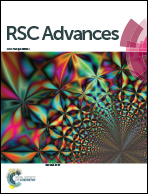α-Fe2O3 nanopillar arrays fabricated by electron beam evaporation for the photoassisted degradation of dyes with H2O2†
Abstract
Vertically aligned α-Fe2O3 nanopillar arrays (NPAs) were fabricated by thermally oxidizing Fe NPAs on Si, quartz and F-doped SnO2 (FTO) substrates prepared by glancing angle e-beam deposition (GLAD). The photocatalytic activity of these NPAs was evaluated by measuring the photodegradation of crystal violet (CV) and methyl orange (MO) in the presence of H2O2 under visible light irradiation. Moreover, the photoelectrochemical (PEC) performance was also studied. Typically the sample oxidized at 400 °C exhibits both the highest degradation efficiency and photocurrent density compared with those oxidized at other temperatures (e.g. 300 °C, 350 °C, 450 °C, 500 °C). This phenomenon might be attributed to a trade-off between two opposite effects. On the one hand, with the increase of the oxidation temperature, the improvement of NPAs' crystallinity will enhance the photocatalytic performance accordingly. On the other hand, increasing oxidation temperature may cause the reduction of oxygen vacancies on the NPAs' surface, which are regarded as the photoreaction active sites. This will thus degrade the photocatalytic performance.


 Please wait while we load your content...
Please wait while we load your content...